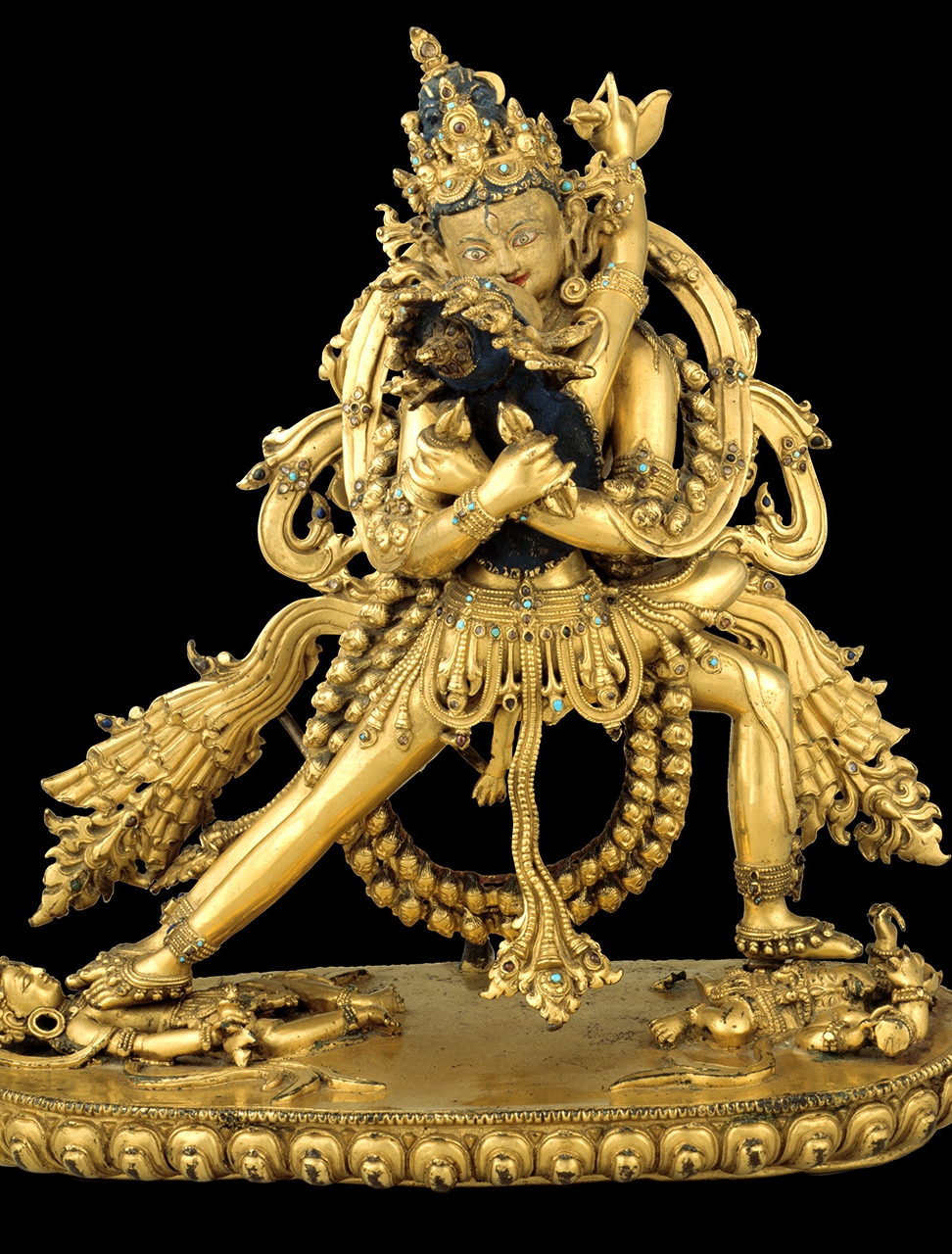
This page is for research and translations on Chakrasamvara (Cakrasaṃvara, known as Demchog (Wheel of Bliss) or Khorlo Dompa in Tibetan). First, are links to posts on this website followed by a very short introduction to the main lineages of Chakrasamvara,
N.B Chakrasamvara is a highest yoga tantra deity and thus should only be practiced and studied if an empowerment has been received from a qualified and recognised lineage teacher.
Research and Translations
The three main Chakrasamvara lineages
In the Tibetan Buddhist Tradition the are three traditions/lineages of Chakrasamvara that have become the most well known are called the ‘lu nag dril sum’, meaning the ‘Three [Chakrasamvara] of the Three [Indian Mahasiddhas]:
- Luipa – the ‘fish-gut ‘ eater

See biography of Luipa from Masters of Mahamudra (tr. Keith Dowman, SUNY 1991):
“Begging in the bazaar one market day, he paused at a house of pleasure, and his karma effected this fateful encounter with a courtesan, who was an incarnate, worldly Dakini. Gazing through him at the nature of his mind, the Dakini said, “Your four psychic centers and their energies are quite pure, but there is a pea-sized obscuration of royal pride in your heart.” And with that she poured some putrid food into his clay bowl and told him to be on his way. He threw the inedible slop into the gutter, whereupon the Dakinis, who had been watching him go, shouted after him angrily, “How can you attain nirvana if you’re still concerned about the purity of your food?”
“Luipa became the great exemplar of what Saraha preached, as confirmed in his own few doha songs, and his sadhana became the inspiration and example for some of the greatest names amongst the mahasiddhas: Kambala, Ghantapa, Indrabhuti, Jalandhara, Krishnacarya, Tilopa and Naropa were all initiates into the Samvara-tantra according to the method of Luipa. Marpa Dopa transmitted the tantra to Tibet, where it has remained the principal yidam practice of the Kahgyu school until today.”
2. Krishnacharya (Nagpopa) – Black Conduct One

Krishnacharya (Nagpopa Chopa, or Nagpo Chopa. nag po spyod pa) associated with the Chakrasamvara Cycle of Tantras. His name is also translated into Tibetan as Nagpopa. Krishnacharya, is also represented in both the Vajrasana and Abhayadatta Systems of the Eighty-four Mahasiddhas.
Krishnacharya is an Indian Buddhist practitioner As a sign of his attainments he is most often depicted with seven parasols and seven drums floating in the sky above. As a mount he is commonly portrayed atop an animated corpse or zombie. He is known in literature for being surrounded by five hundred yogis and yoginis – this however is not typical in painting and sculpture.
Jalandara was the main teacher of Krishnacharya and their principal practices were the Chakrasamvara, Hevajra and Mahamaya Tantras. There are three most famous traditions of Chakrasamvara in Tibet known as the ‘Lu Nag Dril Sum’ which refers to the three famous siddhas Luipa, Krishnacharya and Ghantapa. There are several biographies of Krishnacharya with the longest written by Jonang Taranata who believed himself to be the re-incarnation of the mahasiddha.
3. Ghantapa (Drilbupa) – Bearer of the Bell

For more on Ghantapa’s life-story, and how he changed from celibate monk to siddha with wife and child, see here:
“”So,” said the king, savoring every moment, “the monk who refused to come to my palace because I was a sinful man has a whore’s daughter as a lover with whom he has produced a bastard child, and to top it all off – he drinks liquor!”
“I am without fault,” replied Ghantapa calmly. “Why do you insult me?”
Again, the king repeated his accusation. And again the crowd began to make catcalls. Finally, Ghantapa hurled both his son and the jug of liquor onto the ground. This so frightened the earth goddess that she trembled with fear. The ground gaped open and a geyser of water spurted forth.
The child was instantly transformed into a thunderbolt and the jug of liquor into a bell. Whereupon the yogin, bearing thunderbolt and bell, levitated with his consort into the sky, where they became the deities Samvara and Vajra Varahi joined in father-mother union. They hovered over the heads of the king and the multitude as the waters rose higher and higher.
“We take refuge in the master!” screamed the drowning people. But Ghantapa remained adamant in his samadhi of immutable wrath.”

Depictions/Forms of Chakrasamvara

According to Himalayan Art Resources:
“In painting and art, it is these three forms of Chakrasamvara, associated with the three mahasiddhas, that are most often represented. There is both a principal form, or general appearance, for Chakrasamvara and many minor forms. What distinguishes the appearance of the various forms are the number of faces and arms, colours of the faces and body, with a consort or without.
For both painting and sculpture the Chakrasamvara of the Luipa Tradition is most commonly represented. There are three major indicators for a correct identification of a Luipa form. First, the faces are coloured, from left to right, yellow, blue, green and red. Secondly, the consort, Vajrayogini, red in colour with one face and two hands, is in a posture with both legs wrapped about the torso of Chakrasamvara. Thirdly, in many paintings the Luipa form will also be accompanied by sixty-two retinue mandala deities.
The general description of the Luipa form of Chakrasamvara is identical for the Ghantapa Tradition and also for the less well known Maitripa Tradition of Chakrasamvara.”

